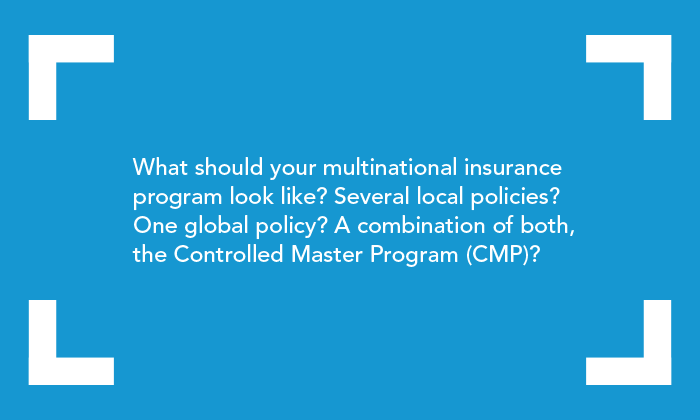Sponsored Content by AIG
Global Program Premium Allocation: Why It Matters More Than You Think

Ten years after starting her medium-sized Greek yogurt manufacturing and distribution business in Chicago, Nancy is looking to open new facilities in Frankfurt, Germany and Seoul, South Korea. She has determined the company needs to have separate insurance policies for each location. Enter “premium allocation,” the process through which insurance premiums, fees and other charges are properly allocated among participants and geographies.
Experts say that the ideal premium allocation strategy is about balance. On one hand, it needs to appropriately reflect the risk being insured. On the other, it must satisfy the client’s objectives, as well as those of regulators, local subsidiaries, insurers and brokers., Ensuring that premium allocation is done appropriately and on a timely basis can make a multinational program run much smoother for everyone.
At first blush, premium allocation for a global insurance program is hardly buzzworthy. But as with our expanding hypothetical company, accurate, equitable premium allocation is a critical starting point. All parties have a vested interest in seeing that the allocation is done correctly and efficiently.
“This rather prosaic topic affects everyone … brokers, clients and carriers. Many risk managers with global experience understand how critical it is to get the premium allocation right. But for those new to foreign markets, they may not understand the intricacies of why it matters.”
— Marty Scherzer, President of Global Risk Solutions, AIG
Basic goals of key players include:
- Buyer – corporate office: Wants to ensure that the organization is adequately covered while engineering an optimal financial structure. The optimized structure is dependent on balancing local regulatory, tax and market conditions while providing for the appropriate premium to cover the risk.
- Buyer – local offices: Needs to have justification that the internal allocations of the premium expense fairly represent the local office’s risk exposure.
- Broker: The resources that are assigned to manage the program in a local country need to be appropriately compensated. Their compensation is often determined by the premium allocated to their country. A premium allocation that does not effectively correlate to the needs of the local office has the potential to under- or over-compensate these resources.
- Insurer: Needs to satisfy regulators that oversee the insurer’s local insurance operations that the premiums are fair, reasonable and commensurate with the risks being covered.
According to Marty Scherzer, President of Global Risk Solutions at AIG, as globalization continues to drive U.S. companies of varying sizes to expand their markets beyond domestic borders, premium allocation “needs to be done appropriately and timely; delay or get it wrong and it could prove costly.”
“This rather prosaic topic affects everyone … brokers, clients and carriers,” Scherzer says. “Many risk managers with global experience understand how critical it is to get the premium allocation right. But for those new to foreign markets, they may not understand the intricacies of why it matters.”
 There are four critical challenges that need to be balanced if an allocation is to satisfy all parties, he says:
There are four critical challenges that need to be balanced if an allocation is to satisfy all parties, he says:
Tax considerations
Across the globe, tax rates for insurance premiums vary widely. While a company will want to structure allocations to attain its financial objectives, the methodology employed needs to be reasonable and appropriate in the eyes of the carrier, broker, insured and regulator. Similarly, and in conjunction with tax and transfer pricing considerations, companies need to make sure that their premiums properly reflect the risk in each country. Even companies with the best intentions to allocate premiums appropriately are facing greater scrutiny. To properly address this issue, Scherzer recommends that companies maintain a well documented and justifiable rationale for their premium allocation in the event of a regulatory inquiry.
Prudent premiums
Insurance regulators worldwide seek to ensure that the carriers in their countries have both the capital and the ability to pay losses. Accordingly, they don’t want a premium being allocated to their country to be too low relative to the corresponding level of risk.
Data accuracy
Without accurate data, premium allocation can be difficult, at best. Choosing to allocate premium based on sales in a given country or in a given time period, for example, can work. But if you don’t have that data for every subsidiary in a given country, the allocation will not be accurate. The key to appropriately allocating premium is to gather the required data well in advance of the program’s inception and scrub it for accuracy.
Critical timing
When creating an optimal multinational insurance program, premium allocation needs to be done quickly, but accurately. Without careful attention and planning, the process can easily become derailed.
Scherzer compares it to getting a little bit off course at the beginning of a long journey. A small deviation at the outset will have a magnified effect later on, landing you even farther away from your intended destination.
Figuring it all out
AIG has created the award-winning Multinational Program Design Tool to help companies decide whether (and where) to place local policies. The tool uses information that covers more than 200 countries, and provides results after answers to a few basic questions.
This interactive tool — iPad and PC-ready — requires just 10-15 minutes to complete in one of four languages (English, Spanish, Chinese and Japanese). The tool evaluates user feedback on exposures, geographies, risk sensitivities, preferences and needs against AIG’s knowledge of local regulatory, business and market factors and trends to produce a detailed report that can be used in the next level of discussion with brokers and AIG on a global insurance strategy, including premium allocation.
“The hope is that decision-makers partner with their broker and carrier to get premium allocation done early, accurately and right the first time,” Scherzer says.
For more information about AIG and its award-winning application, visit aig.com/multinational.

This article was produced by the R&I Brand Studio, a unit of the advertising department of Risk & Insurance, in collaboration with AIG. The editorial staff of Risk & Insurance had no role in its preparation.












